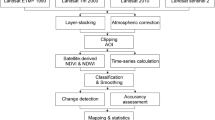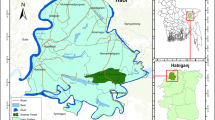Abstract
Increasing interest in wetlands for environmental management requires an understanding of the location, spatial extent, and configuration of the resource. The National Wetlands Inventory is the most commonly used data source for this information. However, its accuracy is limited in some contexts, such as agricultural and forested wetlands. An large number of studies have mapped wetlands worldwide from the perspective of land use and land cover change. However, information on the actual wetland planting areas annually is limited, which greatly impacts ongoing research. In this case study of the West Songnen Plain, we developed a simple algorithm for the quick mapping of wetlands by utilizing their unique physical features, such as annual display of phenological land-cover change of exposed soils, shallow flooding water, and plants from multi-temporal Landsat images. Temporal variations of the Normalized Difference Vegetation Index (NDVI) and Land Surface Water Index (LSWI) derived from Landsat images in 2010 for wetlands at different growth stages were analyzed. Results show that during the ante-tillering phase, the NDVI value (above zero) is lower than the LSWI value of paddies because of flooding of shallow water; during the reproductive and ripening phases, the NDVI value is higher than the LSWI value (above zero); and during the post-harvest wetland planting phase, the NDVI value is still higher than the LSWI value, but the LSWI value is negative. Wetland areas can be detected using one or two images in the optimum time window. The algorithm based on the difference of NDVI and LSWI values derived from Landsat images was used to extract the actual wetland planting area. Validated alongside statistical data, the algorithm showed high accuracy. Therefore, this algorithm highlights the unique features of wetlands and can help in mapping the actual wetland area annually on a regional scale. Results further indicate that the new method has a classification accuracy of 92 %. In comparison, two traditional methods based on Landsat-7/ETM registered accuracy rates of only 83 % and 87 % respectively.




Similar content being viewed by others
References
Acreman, M. C., Fisher, J., Stratford, C. J., Mould, D. J., & Mountford, J. O. (2007). Hydrological science and wetland restoration: some case studies from Europe. Hydrol Earth Syst Sci, 11, 158–169.
Baatz, M., & Schäpe, A. (2000). Multiresolution segmentation – an optimization approach for high quality multi-scale image segmentation (pp. 12–23). Heidelberg: Angewandte Geographische Information sverarbeitung XII. Wichmann-Verlag.
Baker, C., Lawrence, R., Montagne, C., & Patten, D. (2006). Mapping wetlands and riparian areas using landsat ETM + image and decision tree based models. Wetlands, 26(2), 465–474.
Bedford, B. L. (1999). Cumulative effects on wetland landscapes: links to wetland restoration in the United States and southern Canada. Wetlands, 19(4), 775–788.
Cai, Z. C., & Xing, G. X. (1997). Methane and nitrous oxide emissions from rice paddy fields as affected by nitrogen fertilisers and water management. Plant Soil, 196(1), 7–14. doi:10.1023/A:1004263405020.
Castaneda, C., & Ducrot, D. (2009). Land cover mapping of wetland areas in an agricultural landscape using SAR and Landsat imagery. J Environ Manag, 90, 2270–2277.
Chris, L. L., William, H. B., & Jerry, L. W. (2002). Testing a GIS model of habitat suitability for a declining grassland bird. Environ Manag, 30(1), 88–97.
Cowardin, L. M., Carter, V., Golet, F. C., & Laroe, E. T. (1979). Classification of wetlands and deepwater habitats of the United States. US Department of the Interior, Fish and Wildlife Service, Washington, DC (Jamestown, ND: Northern Prairie Wildlife Research Center Online). Available online at: http://www.npwrc.usgs.gov/resource/wetlands/classwet/index.htm (version 04 December 1998).
Dong, Z. Y., Wang, Z. M., Liu, D. W., Li, L., Ren, C., Tang, X., et al. (2013). Assessment of habitats suitability for waterbirds in the West Songnen Plain, China, with remote sensing and GIS. Ecol Eng, 2013(55), 94–100.
EWRP Ethiopian Wetlands Research Programme, 2010 locally sustainable wetland management under conditions of globalization: the challenges faced by small holder communities in Illubabor zone, southwest Ethiopia (p. 20).
Frohn, R.C., Autrey, B.C., Lane, C.R., & Reif, M. (2008). Segmentation and object-oriented classification of wetlands in a karst Florida landscape using multi-season Landsat-7 ETM+imagery. International Journal of Remote Sensing, 1–16.
Hashimoto, H., Melton, F., Ichii, K., Milesi, C., & Wang, W. (2010). Evaluating the impacts of climate and elevated carbon dioxide on tropical rainforests of the western Amazon basin using ecosystem models and satellite data. Glob Chang Biol, 16, 255–271.
Hunt, E. R., & Rock, B. N. (1989). Detection of changes in leaf water-content using near-infrared and middle-infrared reflectances. Remote Sens Environ, 30(1), 43–54. doi:10.1016/0034-4257(89)90046-1.
IPCC. (2001). Climate Change 2001, The scientific basis. Contribution of working group 1 to the third assessment report of the intergovernmental panel on climate changes. New York: Cambridge University Press.
Karlsen, S. R., Tolvanen, A., Kubin, E., Poikolainen, J., Hogda, K. A., Johansen, B., et al. (2008). MODIS-NDVI-based mapping of the length of the growing season in northern Fennoscandia. Int J Appl Earth Obs Geo-Inf, 10, 253–266.
Liu, X. (2001). Management of degraded land and agricultural development in the Songnen Plain China. Beijing: Science Press (in Chinese).
Liu, J. Y., Liu, M. L., Tssian, H. Q., Zhuang, D. F., Zhang, Z. X., Zhang, W., Tang, X. M., & Deng, X. Z. (2005). Spatial and temporal patterns of China’s cropland during 1990–2000: an analysis based on Landsat TM data. Remote Sens Environ, 98, 442–456.
Loveland, T. R., & Dwyer, J. L. (2012). Landsat: building a strong future. Remote Sens Environ, 122(Landsat Legacy Special Issue), 22–29. doi:10.1016/j.rse.2011.09.022.
Lu, D., Moran, E., & Batistella, M. (2003). Linear mixture model applied to Amazonian vegetation classification. Remote Sens Environ, 87, 456–469.
Martinez-Casasnovas, J. A., & Martin-Montero, A. (2005). Mapping multi-year cropping patterns in small irrigation districts from time-series analysis of Landsat TM images. Eur J Agron, 23(2), 159–169. doi:10.1016/j.eja.2004.11.004.
May, D., Wang, J., Kovacs, J., & Muter, M. (2002). Mapping wetland extent using IKONOS satellite imagery of the O’Donnell point region, Georgian Bay, Ontario. London: Department of Geography, University of Western Ontario.
Muller, A., Jena, F. (2003). Advanced land use classification using polarimetric high-resolution SAR. Definiens, 1–3.
Mwita, E., Menz, G., Misana, S., Becker, M., Kisanga, D., & Boehme, B. (2013). Mapping small wetlands of Kenya and Tanzania using remote sensing techniques. Int J Appl Earth Obs Geoinformation, 21, 173–183.
O’Neill, M. P., Schmidt, J. C., Dobrowolski, J. P., Hawkins, C. P., & Neal, C. M. (1997). Identifying sites for riparian wetland restoration: application of a model to the upper Arkansas River Basin. Restor Ecol, 5, 85–102.
Okamoto, K., & Fukuhara, M. (1996). Estimation of paddy field area using the area ratio of categories in each mixel of Landsat TM. Int J Remote Sens, 17(9), 1735–1749. doi:10.1080/01431169608948736.
Ramita, M., Inakwn, O. A., & Tiho, A. (2009). Improving the accuracy of land Use and land cover classification of landsat data using post-classification enhancement. Remote Sens, 1, 330–344.
Ramsar. (2004). The Ramsar convention manual: a guide to the convention on wetlands (Ramsar, Iran, 1971), 3rd ed., RAMSAR Convention Secretariat, Gland, Switzerland. Available online at: http://www.ramsar.org/lib/lib_manual2004e.htm.
Rundouist, D., Narumalani, S., & Narayanan, R. (2001). A review of wetlands remote sensing and defining new considerations. Remote Sens Rev, 20, 207–226.
Running, S. W., Nemani, R. R., Heinsch, F. A., Zhao, M., & Reeves, M. (2004). A continuous satellite-derived measure of global terrestrial primary production. Bioscience, 54, 547–560.
Sai, M. V. R. S., & Rao, P. V. N. (2008). Utilization of Resourcesat-1 data for improved crop discrimination. Int J Appl Earth Obs Geoinformation, 10(2), 206–210. doi:10.1016/j.jag.2008.02.009.
Stuckens, J., Coppin, P. R., & Bauer, M. E. (2000). Integrating contextual information with per-pixel classification for improved land cover classification. Remote Sens Environ, 71, 282–296.
Tennakoon, S. B., & Murty, V. V. N. (1992). Estimation of cropped area and grain-yield of rice using remote-sensing data. Int J Remote Sens, 13(3), 427–439. doi:10.1080/01431169208904047.
Tucker, C. J. (1979). Red and photographic infrared linear combinations for monitoring vegetation. Remote Sens Environ, 8(2), 127–150. doi:10.1016/0034-4257(79)90013-0.
Wang, Z. M., Song, K. S., Zhang, B., Liu, D. W., Ren, C. Y., Luo, L., et al. (2009). Shrinkage and fragmentation of grasslands in the West Songnen Plain, China. Agriculture.
Wang, Z. M., Huang, N., Luo, L., Li, X. Y., Ren, C. Y., Song, K. S., & Chen, J. M. (2011). Shrinkage and fragmentation of marshes in the West Songnen Plain, China, from 1954 to 2008 and its possible causes. Int J Appl Earth Obs Geoinformation, 13, 477–486.
Weiers, S., Bock, M., Wissen, M., & Rossner, G. (2004). Mapping and indicator approaches for the assessment of habitats at different scales using remote sensing and GIS methods. Landsc Urban Plan, 67, 43–65.
White, D. C., & Lewis, M. M. (2011). A new approach to monitoring spatial distribution and dynamics of wetlands and associated flows of Australian Great Artesian Basin springs using QuickBird satellite imagery. J Hydrol, 408, 140–152.
Woodcock, C. E., & Allen, R. (2008). Free access to Landsat imagery. Science, 320(5879), 1011. doi:10.1126/science.320.5879.1011a.
Xiao, X., & Boles, S. (2002). Observation of flooding and rice transplanting of paddy rice fields at the site to landscape scales in China using VEGETATION sensor data. Int J Remote Sens, 23(15), 3009–3022. doi:10.1080/01431160110107734.
Zha, Y., & Gao, J. (2003). Use of normalized difference built-up index in automatically mapping urban areas from TM imagery. Int J Remote Sens, 24(3), 583–594. doi:10.1080/01431160210144570.
Zhang, Y., & Wang, C. (2009). Mapping paddy rice with multitemporal ALOS/PALSAR imagery in southeast China. Int J Remote Sens, 30(23), 6301–6315. doi:10.1080/01431160902842391.
Zhao, B., Yan, Y., Guo, H. Q., He, M. M., Gu, Y. J., & Li, B. (2009). Monitoring rapid vegetation succession in estuarine wetland using time series MODIS-based indicators: an application in the Yangtze River Delta area. Ecol Indic, 9, 346–356.
Acknowledgments
This study was supported by the Key Deployment Project of Chinese Academy of Sciences (NO. KZZD-EW-08-02) and CAS/SAFEA International Partnership Program for Creative Research Teams.
Author information
Authors and Affiliations
Corresponding author
About this article
Cite this article
Dong, Z., Wang, Z., Liu, D. et al. Mapping Wetland Areas Using Landsat-Derived NDVI and LSWI: A Case Study of West Songnen Plain, Northeast China. J Indian Soc Remote Sens 42, 569–576 (2014). https://doi.org/10.1007/s12524-013-0357-1
Received:
Accepted:
Published:
Issue Date:
DOI: https://doi.org/10.1007/s12524-013-0357-1




